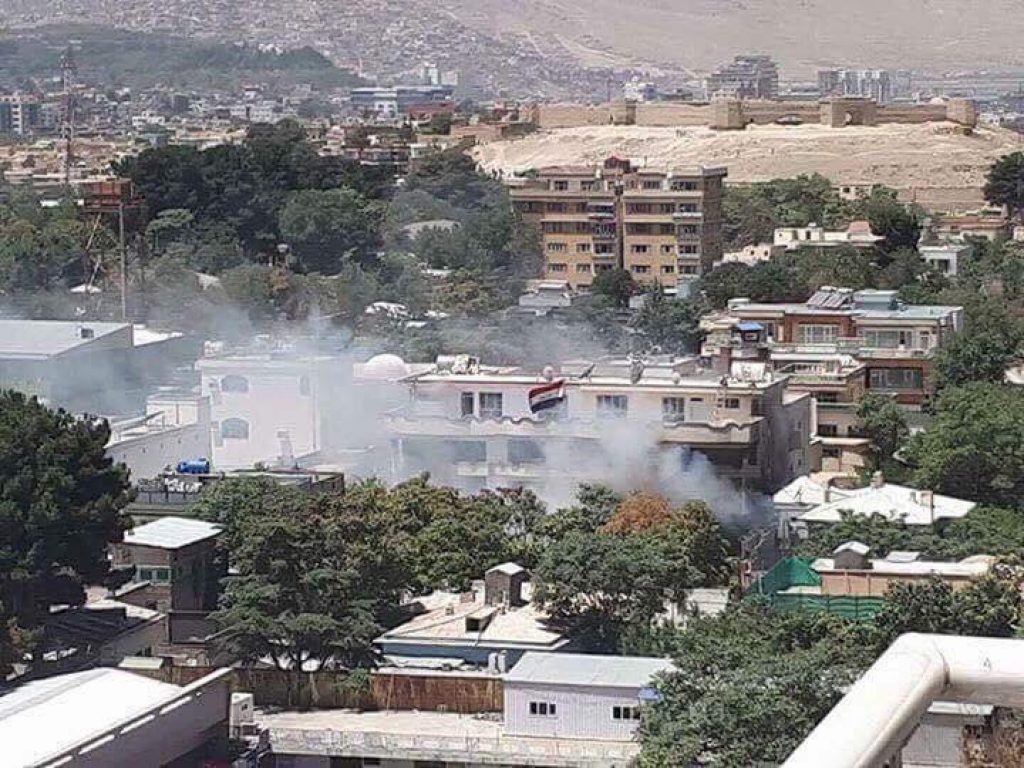
Afghanistan’s Ministry of Interior Affairs released this photo of the Iraqi embassy in Kabul after it was attacked this morning.
The Islamic State’s Wilayah Khorasan (or Khorasan province) attacked the Iraqi embassy in Kabul earlier today. The self-declared caliphate claimed the assault via short messages from its Amaq News Agency and then released a longer statement on social media channels.
The “inghimasi attack” was carried out by two “brothers,” identified as Abu Julaybib al-Khurasani and Abu Talhah al-Balkhi, according to the group. Inghimasis are generally well-trained commandos who are prepared to die in battle.
The two terrorists were armed with explosive vests and light arms. Amaq claims that one of the two detonated his suicide vest on security guards and the other opened fire on personnel inside the embassy.
The Afghan government’s account of the raid differs slightly from the Islamic State’s, saying that four jihadists were responsible, not two. According to Afghanistan’s Ministry of Interior Affairs “a group of four suicide bombers attacked [the] Iraqi embassy in Kabul city” around 11:10 AM local time. “One of the suicide bombers blew himself up at the entrance gate of the embassy at first and opened way to other attackers.” A shootout lasting several hours then ensued.
This is a standard jihadist tactic, as the Islamic State and other groups frequently use suicide bombers to clear the path for their comrades.
It is not clear how many people were killed or wounded in the assault. The Islamic State claims that seven guards outside the building were killed and another 20 “apostates” perished inside. These casualty figures have not been confirmed by independent sources.
The Islamic State portrays the raid on the Iraqi embassy as part of an “open war” between the Sunni “mujahideen” and the Shiite “polytheists.” This is a typical narrative deployed by Abu Bakr al Baghdadi’s loyalists around the globe, as they frequently target Shiite civilians. Wilayah Khorasan has specifically targeted gatherings of Afghanistan’s predominately Shiite Hazara minority. The Islamic State’s men have attacked Shiite mosques and peaceful demonstrations in Kabul, thereby causing some of Afghanistan’s worst massacres in recent years.
Kabul hit hard by “suicide and complex” attacks, UN finds
Nearly 16 years after the US invaded Afghanistan in response to the Sept. 11, 2001 hijackings, Kabul is regularly struck by spectacular terrorist attacks.
Earlier this month, the United Nations Assistance Mission in Afghanistan (UNAMA) released its midyear report on civilian casualties. Between Jan. 1 and June 30, 2017, UNAMA “documented 5,243 civilian casualties (1,662 deaths and 3,581 injured)” throughout all of Afghanistan.
Nearly 20 percent of these civilian casualties — 1,048 (“219 deaths and 829 injured”) — occurred in Kabul province and “mainly” within the city of Kabul itself. Kabul province witnessed a higher number of civilian casualties than any other province. This was due to a series of bombings and raids carried out by Wilayah Khorasan and the Taliban.
The overwhelming majority of civilian casualties in the Afghan capital during the first six months of 2017 were caused by what UNAMA describes as “suicide and complex” attacks, such as the Islamic State assault on the Iraqi embassy earlier today. Indeed, civilian casualties from these types of operations rose by 15 percent in Afghanistan during the first six months of 2017, as compared to the same period last year. “Suicide and complex” attacks are now the leading cause of civilian casualties, according to UNAMA, and have hit Kabul city especially hard.
A timeline of the most lethal “suicide and complex” attacks in Kabul this year can be found below. These are only some of the jihadist operations carried out in the Afghan capital.
Jan. 10, 2017: 109 civilians were killed (34) or wounded (75) when Taliban suicide bombers led a coordinated raid targeting intelligence officials and government workers near the Afghan Parliament in Kabul.
Feb. 7: A Wilayah Khorasan suicide bomber struck the exit gate outside of Afghanistan’s supreme court in Kabul, killing or injuring 63 civilians.
Mar. 1: The Taliban killed or injured 81 civilians during a complex assault on military, police, and intelligence buildings.
Mar. 8: A Wilayah Khorasan suicide assault team struck the Sardar Mohammad Daud Khan Hospital in Kabul city. The hospital is the largest medical facility in Afghanistan for military personnel and their families. The jihadists killed 49 people and wounded 88 others, with 48 of the casualties (“26 deaths and 22 injured,” according to UNAMA) being civilians.
May 31: A suicide bomber detonated an explosive-laden truck near diplomatic facilities in the heart of Kabul during rush hour, causing “544 civilian casualties (92 deaths and 491 injured),” according to UNAMA. It is the “deadliest incident documented by UNAMA since 2001,” but no group claimed responsibility. The Afghan government quickly blamed the Haqqani Network, the most powerful Taliban subgroup, as well as Pakistani officials. Sirajuddin Haqqani and the Taliban have denied responsibility. However, if Wilayah Khorasan had carried out the bombing, then it would almost certainly have claimed the operation. The Taliban is concerned with how its violence is perceived, whereas the Islamic State branch has no such reservations. Obviously, the Taliban has a significant interest in destabilizing the Afghan capital, even if it doesn’t want to be seen as indiscriminately killing civilians. In its midyear report for 2017, UNAMA found that the Taliban killed or wounded more civilians than any other party in the conflict. This has been true for years. And UNAMA’s report did not even count the May 31 suicide bombing as a Taliban operation, because the UN arm couldn’t evaluate the intelligence cited by officials and no group claimed responsibility.
July 24: A Taliban suicide bomber rammed his vehicle-borne improvised explosive device (VBIED) into a bus carrying Afghan government workers. The Taliban claimed that the bombing targeted “intelligence officials.” Nearly three dozen people were killed, according to initial casualty reports.








1 Comment
Time for a huge yard sale! HUGE!!!